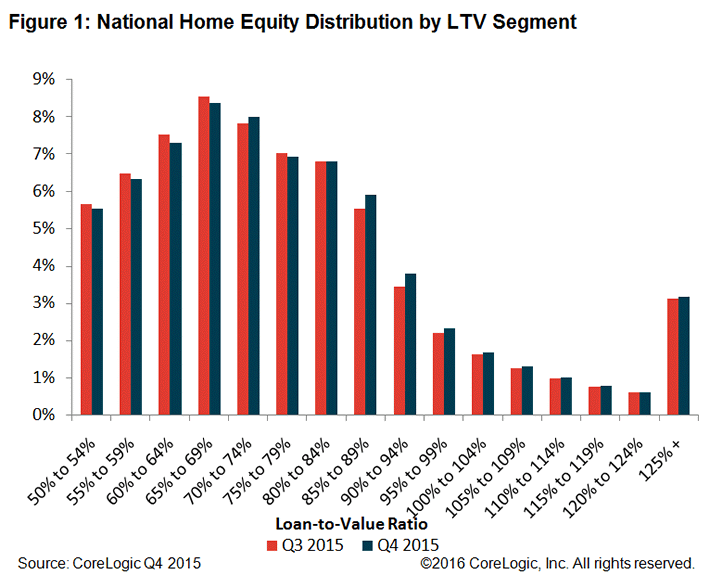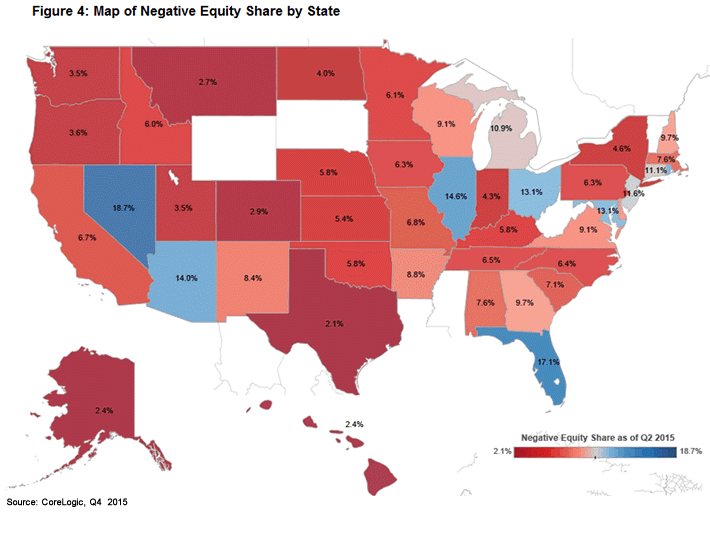The share of homeowners with positive equity in their homes crossed the 90 percent mark in 2015 according to CoreLogic. Over the course of the year 1 million previously underwater homeowners regained a portion of the equity they lost when the housing market crashed in the middle of the last decade. That brought the total number of houses valued for more than the unpaid principal balance of their mortgage or mortgages to 46.3 million properties or 91.5 percent of all mortgaged homes. The dollar value of borrower equity increased by $652 billion in the fourth quarter of 2015 compared to the fourth quarter of 2014.
At the end of the year, there were approximately 4.3 million properties that were still underwater, 8.5 percent of mortgaged homes. This was a decrease of 1 million or 19.1 percent year over year.

CoreLogic's analysis also indicates that approximately 120,000 properties lost equity between the third quarter and the fourth quarter of 2015, resulting in an increase in the national aggregate value of negative equity of 1.8 percent. That is, negative equity increased by $5.5 billion, from $305.5 billion to $311 billion. CoreLogic did not provide any analysis for that increase nor explain if there was a particular geographic locus. On an annual basis, total negative equity declined from $348 billion in Q4 2014, representing a decrease of 10.7 percent in 12 months.
There are approximately 50 million homes in the country with a mortgage and close to one-fifth (18.9 percent) are still considered "under-equitied" i.e. with less than 20 percent equity. Of those, 1.2 million are near negative in their equity with less than 5 percent value over their mortgage balance. Borrowers who are under-equitied may have a difficult time refinancing their existing homes or obtaining new financing to sell and buy another home due to underwriting constraints. Those near-negative borrowers are considered at risk of moving into negative equity if home prices fall.
"In Q4 of last year home equity increased by $680 billion or 11.5 percent, the 13th consecutive quarter of double digit growth," said Frank Nothaft, chief economist for CoreLogic. "The improvement in equity reflects positive home prices and continued deleveraging of mortgage balances by households."
"The number of homeowners with more than 20 percent equity is rising rapidly," said Anand Nallathambi, president and CEO of CoreLogic. "Higher prices driven largely by tight supply are certainly a big reason for the rise, but continued population growth, household formation and ultralow interest rates are also factors. Looking ahead in 2016, we expect home equity levels to continue to build, which is a good thing for the long-term health of the U.S. economy."
Nevada remains the state with the highest percentage of underwater homes at 18.7 percent, followed by Florida (17.1 percent), Illinois (14.6 percent), Arizona (14 percent) and Rhode Island (13.5 percent). These five states combined account for 30.8 percent of negative equity in the U.S., but only 16.5 percent of outstanding mortgages. The state with the highest percentage of positive equity is Texas at 98 percent followed closely by Alaska, Hawaii, Montana, and Colorado, all in the 97+ percent range.

Approximately 1.7 million underwater borrowers hold both first and second liens accounting for $140 billion, or 45 percent of negative equity. The average mortgage balance for this group of borrowers is $304,000 and the average underwater amount is $82,000.
Approximately 2.6 million underwater borrowers hold first liens without home equity loans with an average mortgage balance of $240,000 and negative equity of $65,000. These borrowers account for $171 billion, or 55 percent, in aggregate negative equity,
The bulk of positive equity for mortgaged residential properties is concentrated at the high end of the housing market. For example, 95 percent of homes valued more than $200,000 more have equity compared with 87 percent of homes valued at less than $200,000.







